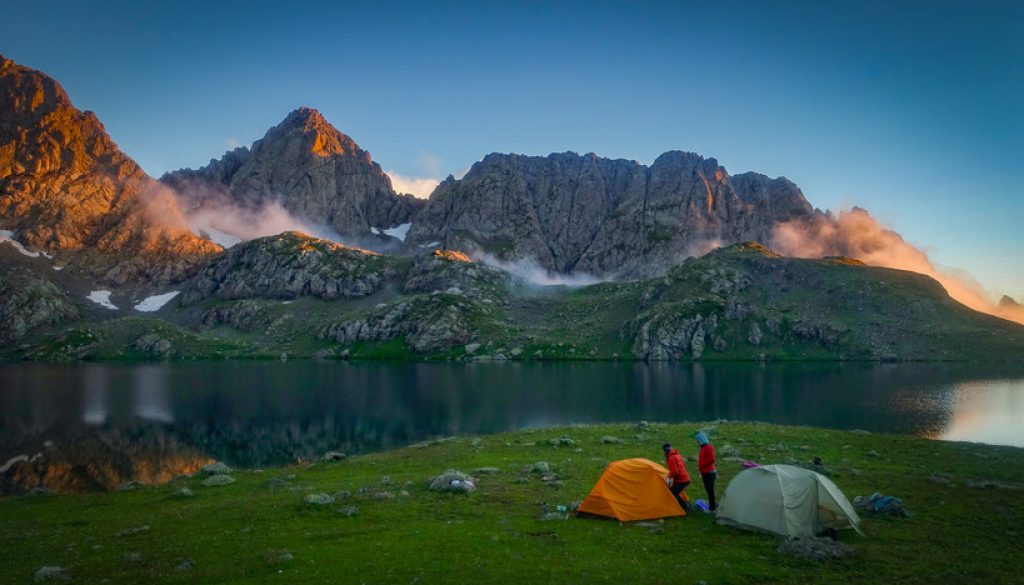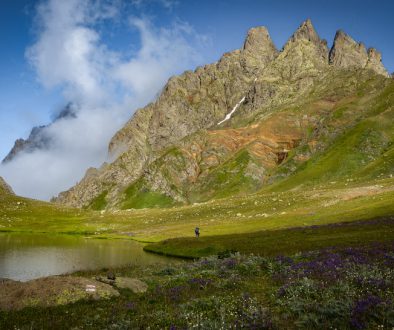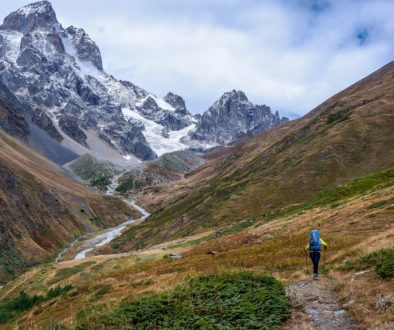#BlazetheTCT Day 14: Svaneti to Samegrelo
Welcome to Day 14 of #BlazeTheTCT!
Today, we’re leaving the crowds behind as we continue along the TCT– first through the small villages of the lesser-visited side of Upper Svaneti, and then heading into the wild, rugged beauty of Samegrelo.

Along the way, we’ll see how the trail has transformed livelihoods in Svaneti’s villages, meet some of the entrepreneurs welcoming tired hikers into their homes and sharing their culture, and learn about the TCT trail building projects that have opened key pieces of this incredible section.
We won’t even try to hide it: For many of us, this is the section that made us fall in love with the TCT in the first place. The strong currents of Svan culture intertwined with modern-day connectivity, the remarkable cultural monuments in the middle of the mountains, the steep passes and sweeping views– they all make it a trek that’s hard to forget.
If you’ve been, let us know whether you agree. And if you haven’t yet, we hope you’ll go see for yourself.
So lace up those boots– we’ve got just 200km left until the Black Sea, and it’s time to hit the trail!
Happy trails,
Meagan

A lone Svan tower along the trail. Photo by hiker Tanel Tilk.
Descend Bak Pass to Etseri
You’ve spent at least a good hour staring at Mt. Ushba. How could you not? The clouds keep dancing around its jagged peaks, hiding and revealing something new each minute.

Mt. Ushba from Bak Pass. Photo by Tanel Tilk.
But at last you’ve started to get a bit cold, so it’s time to get that blood moving again and descend.
The trail winds around the curve of the mountain, passing shepherd huts as you descend to Etseri. As you enter the town, keep an eye out for its half-ruined towers and the Pkhutreri Church of the Archangels, built in the 10th century with carved stones and original 11th-century paintings.
Here, perhaps you’ll meet some TCT legends at the Hanmer Guesthouse: Lali from Svaneti & Tony from the UK/Canada, who have been hosting travelers and sharing Svan culture for years. Go soon, though– they’re heading into their well-earned retirement soon, although the Hanmer guesthouse will continue!

Village life along the trail between Etseri and Pari.
Hike gentle village roads & historical trails from Etseri to Kichkhuldashi
You continue on your way, following quiet village dirt roads that occasionally turn into farm tracks that occasionally turn into open fields. You make your way through Pkhutreri, Pari, Zagari, Gheshderi, towards Kichkhuldashi.

The road to Kichkhuldashi.
Throughout it all, you have two constant companions: the trail blazes guiding you and the dramatic peaks of the Svaneti range across the valley.

The Svaneti range, looming across the valley from the trail near Etseri. Photo by Tanel Tilk.
As you approach Kichkhuldashi, it looks like a tiny settlement– barely inhabited. And that’s true. But it’s a tiny settlement with a big heart, spurring a quiet tourism revolution in the villages of Svaneti.
Valeri and Maro Vibliani are the last two residents of Kichkhuldashi. They’re mountain people to their core, firmly holding onto their self-sufficient stronghold overlooking the valley even when the rest of the village migrated to bigger towns.

Maro and Valeri Vibliani at their home in Kichkhuldashi. Photo by Bryce Reif.
But Valeri and Maro stayed– and when the TCT project began, they became some of the trail’s first champions, showing us routes through the mountains and opening a guesthouse to welcome hikers.

Valeri and Paul during the earliest scouting days of the TCT, 2015.
Nowadays, they’ve got a small but vibrant operation– even their grandchildren come up in the summer to hang out and help at the guesthouse– and Valeri and Maro are always happy to meet hikers.
If you’re lucky– or if you’re a couple chacha shots deep– Valeri will show you his homemade skis and tell you about his bear-hunting days.

Valeri with 2023 volunteers. Photo by Bryce Reif.
Appreciate the TCT steps on your way to Nakra
After a memorable night chatting with Valeri & Maro, you set off the next morning on the trail to Nakra– a relatively short section with a lot of TCT history.
This was the TCT’s very first volunteer project, back in 2016. A group of diverse, fun, hardworking volunteers showed up from all over the world to build the steps that now lead hikers from the riverbank to Kichkhuldashi.
And the section of the trail that they built opened up this incredible region to hikers, putting it squarely on the map and creating opportunities for folks like Valeri to start businesses.

Sopo working on a set of steps near Kickhuldashi in 2016.
But as the trail builders on this list know, though, the story doesn’t stop there. In order to have a good, safe, accessible trail, you don’t just need to build it well– you also need to maintain it.
That’s especially true in a place like Svaneti, where the harsh winters and overpowering spring rains often destroy the old paths, cause landslides, and wash away bridges.
So TCT Georgia has sent crews back there for several summers since 2016. They’ve painted blazes, built and rebuilt bridges, constructed and repaired steps, rerouted trails above landslides, and kept the path clear of overgrowth.


2023 trail crews improving the trail near Kichkhuldashi.
And of course, they’ve had the chance to become friends with Valeri and Maro– an equally important part of the whole endeavor.
That’s both because Valeri and Maro are wonderful people– and because good long-term community relationships like this are essential to making a long-distance trail work in a context as complex as the Caucasus.
And that’s something we get reminded of at the start of each summer, when our Georgia team typically gets a call from Valeri: “Hey, the bridge is washed out again… want me to fix it?”

A bridge near Kickhuldashi built by volunteer crews in 2023.
Climb from Nakra to dramatic Utviri Pass
Continuing your journey westwards, you descend to the small town of Nakra. It’s the perfect place to spend the night, with a couple excellent guest houses who will feed you to your heart’s content. Don’t forget to stop at the mineral spring by the river, a community landmark that just happens to also hit the stop for thirsty hikers.
The next morning, you start the long, steep climb on a jeep track towards Utviri Pass. This one is a bit of a slog– sweating your way through the humid forest and trying to nicely merge with the traffic of cattle on their way to their pastures– but it’s worth it when you reach the shepherd huts just above treeline and the panoramic views of the snow-capped Caucasus spill out before you.

Climbing towards Utviri Pass. Drone photo by Tanel Tilk.
Utviri Pass is one of our favorite camping spots– both sides of the pass have fantastic grassy patches to pitch your room with a view and enjoy the show.
You settle in for the night, bundling in your sleeping bag when the temperature drops dramatically and the dew laces the outside of your tent with moisture.


Evening and morning at Utviri Pass. Photos by Tanel Tilk.
The morning sees you descending to the cluster of villages known as Chuberi.
First you cross the pass, soaking in the morning light, and gingerly navigate a small section of trail dug into a landslide. Then you’re following a small shepherding path down the ridge, spying a small cluster of semi-wild horses tossing their manes on the hills nearby.
After a long descent, you re-enter the forest, finishing a long day at one of the new guesthouses in the village. Chuberi is another place that has seen a revival alongside the growth of the trail– and we’re delighted to see this wonderful village starting to get some of the attention it deserves.


Guesthouse owner Khato at the positively delightful Hotel Chubezeni in Chuberi.
Follow the Neskra River to Khaishi– your last resupply
And from here, we turn south and start our slow journey to the Black Sea. We’re hiking into our last region of Samegrelo and the dramatic Egrisi range.
Before you get there, though, it’s a long road to walk, following the Neskra River along its path to join the mighty Enguri.

Perhaps you walk the whole way, observing the changing villages around you– the traditional houses juxtaposed against the new road construction and signs of hydropower development.
Or perhaps a friendly truck driver waves at you in amusement, gesturing at the sea next to him, and you hop in.

At the transit stop of Khaishi, you restock on basic supplies for the next section– several days in the wilderness as you head into the imposing mountains of the Egrisi Range.
The shopkeepers giggle at the ridiculous number of Snickers bars you’re purchasing– you’re going to survive on that?— but the selection of typical trail food is limited, so you make do with what’s available. (And hey– we will never tell you that that’s too many Snickers.)
Hike into the Egrisi Range
You hike out of the small town of Khaishi, your backpack laden with Snickers bars, sharing the dirt road with rumbling Kamaz trucks as you make your way to the tiny settlement of Zeda Vedi.
The road doesn’t last that long, though: Soon enough you’re back in the kind of towering giant hogweed and rhododendrons you thought you left back in Racha.
But even though you have to hunt carefully for the path in a few sections, and carefully ford some rivers, and occasionally yank your squelching feet out of the ankle-deep mud, you have to admit it: part of you missed this feeling of wildness.
You climb higher and higher, your climb occasionally slowed down by fields of ripe blueberries. The trail disappears and reappears. You crest the Natakhtish-Dudi pass at 2,770m, admiring some of your last panoramic views of the Greater Caucasus ridge. And this one comes with a bonus: the majestic twin snow-capped domes of Mt. Elbrus, the highest mountain in Europe, lying behind.

View of Mt. Elbrus from the side trail from Nakra. Photo by Elizabeth Yancey
As you climb higher, the terrain turns progressively rockier, until you’re picking your way up to notches in the pass. You begin to pass the series of small lakes that define this lake: Didi Ghele lake, usually covered with ice; Kailashi lake, named for its shape resembling a heart.

We’re in the big mountains now.
And at last you crest the last pass and get your first views of your camp spot for the night– maybe several, if you want to relax and swim and explore the many side routes around the area– Didi Tobavarchkhili, the “big silver lake.”

You settle in and take a plunge in the lake before setting up your tent, watching the mist swirl around the lake.
And here’s where we’ll leave you today: sitting back, scarfing down a Snickers bar, and delighted to be out here in one of the wildest corners of Georgia.
We’ll see you tomorrow for our very last day on the TCT– slowly descending to civilization and making our way towards that long-awaited swim in the Black Sea.

And that’s 1,400 km down on the TCT.
We’ve got just one more day left on our virtual thru-hike and on our campaign to blaze the TCT.
We hope you’ve enjoyed coming with us on the trail and meeting some of the people and places behind it. Over our 15 days of hiking the TCT, we’re aiming to raise $30,000 to blaze new sections of the trail and to continue our work to make these spectacular areas accessible.
If you’ve enjoyed the trail in the past or are dreaming of hiking it someday, today’s the day to take action– please join us to make these efforts possible! Donate $15 or more and share with 15 friends today to blaze the TCT.
Let’s make some waves in the last day– and we’ll see you tomorrow for that celebratory swim in the Black Sea!
If you’ve enjoyed the trail in the past or are dreaming of hiking it someday, please join us to make these efforts possible. Donate $15 or more and share with 15 friends today to blaze the TCT.
Thanks for all your support, and happy trails – we’ll see you back on the TCT tomorrow!
Meagan & the TCT team






